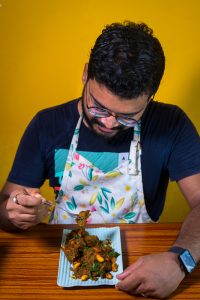6.8 Den Braten riechen

Mahlzeit!
Zum Aufwärmen machen wir unseren Tagesminiplausch und eine Wiederholung.
Wiederholung
In the previous lesson, you learned about die Zwischenmahlzeit and how to ask another out for coffee (and how how to respond when invited). Let’s review what you have learned.
In what ways could you invite someone to coffee? Think back on the question(s) that you learned in the previous lesson. Practice writing down and saying aloud that question now.
Lektionsüberblick
You might remember from Deutsch im Alltag 1, that if you can smell the roast in German (den Braten riechen), it does not mean that it is time for dinner. It means you can tell something or someone is a problem. (The closest English equivalent is “to smell a rat”.) In this lesson on the die warme Mahlzeit, you are more likely to encounter a roast than a problem.
You might recall that die warme Mahlzeit is generally das Mittagessen (midday meal) in Germany. (Lektion 6.6 covered the typical kalte Mahlzeit.) You can get a warme Mahlzeit in the Mensa (dining hall) at your university and in the Kantine at your workplace. “Mahlzeit!” is a typical greeting among co-workers as they head off to lunch. People used to commonly wish each other a “gesegnete Mahlzeit” (“blessed meal”) and in the 19th century, this was often shorted to just “Mahlzeit!” Now you can hear it at any workplace or jokingly among students at the university.If you are eating the warme Mahlzeit in other settings (at home, at someone’s home, in a restaurant), then people generally wish each other a Guten Appetit! once the food has been served and before they begin eating. Often, the warme Mahlzeit is concluded with a Nachtisch (dessert).
In the end, while talking about the so-called warme Mahlzeit, you will be able to 1) talk about the frequency with which you consume some typical foods, 2) ask others about their preferences, and 3) talk about your preferences.
Was weißt du schon?
Let’s do a skills check before we begin.
| Noch nicht start klar?
Du kannst immer auf die gleiche 1010-Lektion zurückgreifen! |
Not confident about starting this lesson?
You can always review the same Lektion from 1010. |
1) die warme Mahlzeit
You have already learned some warm foods that would often be enjoyed during die warme Mahlzeit. This meal often has three parts: a vegetable, a protein, and a side. Let’s review the vegetable and proteins you are already familiar with (Gemüse, Fleisch/Fisch) with some added specificity. You will also be introduced to sides (die Beilagen) and some dishes. Be sure to click through each of the slides (pay attention to the large and small arrows).
Now listen as the following people describe how they sometimes eat. Look for some descriptors that you have learned previously, as well as some new ones. Words that describe the foods are in bold. What do you think the boldfaced words might mean?
 |
 |
 |
| Ich heiße Rand und ich esse oft warm mittags. Heute esse ich frisch gekochtes Curry mit viel Gemüse. Das Curry ist scharf gewürzt und sehr lecker! Das Curry ist eine ausgewogene Mahlzeit mit Fleisch, Gemüse und Reis. |
Ich heiße Wilhelm und habe wenig Zeit mittags warm zu essen. Ich esse immer eine Fertigmahlzeit wie Ramen. Fertigmahlzeiten haben viel Salz und sind nicht besonders gesund aber sie sind heiß, schnell und günstig. Fertig-Ramen sind nur Nudeln, also esse ich mittags einseitig. |
Ich heiße Valeria und ich esse manchmal mittags warm. Ich gehe gern essen und bestelle oft eine vegetarische Pizza oder esse eine Fertigmahlzeit zu Hause. |
Let’s check what you understood about what you read and heard.
Jetzt bist du dran!
2) Asking about food preferences
Food is an important topic of conversation with new friends as well as friends and family members we’ve known for ages. Here is how to ask about food preferences. Listen and repeat.
 |
Let’s practice.
Jetzt bist du dran!
Hamburg im Blickpunkt

Die Elbphilharmonie (umgangssprachlich Elphi) ist ein im Januar 2017 eröffnetes Konzerthaus in Hamburg. Sie wurde mit dem Ziel geplant, ein neues Wahrzeichen der Stadt und ein „Kulturdenkmal für alle“ zu schaffen. Das 110 Meter hohe Gebäude liegt im Stadtteil HafenCity. Es wurde unter Einbeziehung der Hülle des früheren Kaispeichers A (Baujahr 1963) errichtet. Auf diesen Sockel wurde ein moderner Aufbau mit einer Glasfassade gesetzt, die an Segel, Wasserwellen, Eisberge oder einen Quarzkristall erinnern soll. Die Elbphilharmonie ist das höchste bewohnte Gebäude Hamburg.
The Elbphilharmonie (popularly nicknamed Elphi) is a concert hall in Hamburg opened in January 2017. It was developed with the plan to create a new landmark for the city and a “cultural monument for everyone”. The building is located in the HafenCity quarter of Hamburg and is 110m (354 ft) high. The new construction rests on top of an old brick warehouse (Kaispeicher A, built in 1963). The modern addition of glass resembles a hoisted sail, water waves, an iceberg or a quartz crystal. It is the tallest inhabited building in Hamburg.
3) Lieber und am liebsten
 |
 |
 |
 |
|
Ich esse lieber warm zu Abend. |
Ich esse lieber eine Pizza als einen Hamburger. |
Wir essen lieber Nudeln als Salat. |
Am liebsten esse ich frisch gekochtes Essen. |
Let’s practice!
Jetzt bist du dran!
Zum Schluß
 |

*As you conclude this lesson, don’t forget to check Canvas!*

Media Attributions
- 1020-banner-large-reduced
- Photo of man eating by pexels-kuntal-maity-1063289075-29452380
- Photo of man eating Ramen by pexels-taryn-elliott-4098989
- Photo of girl eating pizza by pexels-athena-2323183 (1)
- Comic made at www.MakeBeliefsComix.com
- Photo by pexels-polina-tankilevitch-6073637
- Photo of woman cooking by pexels-yaroslav-shuraev-8845651
- Photo of hamburger and fries by pexels-spencer-4393010

